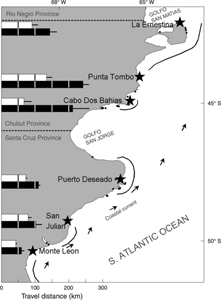
Following the Fish
P. Dee Boersma, Ginger A. Rebstock, Esteban Frere, Sue E. Moore
Ecological Monographs 79(1): 59-76. 2009.
Abstract
We tested four predictions for central-place foragers provisioning offspring along a gradient in primary production spanning 1000 km of coastline in Argentina, using male Magellanic Penguins (Spheniscus magellanicus). Three of the predictions were supported. (1) Foraging trip distances corresponded with the production gradient; penguins swam shorter distances (mean maximum distance: 60–110 km) at the southern colonies where production is higher and prey species aggregate nearshore, and longer distances (143–242 km) at the northern colonies where production is lower and prey species aggregate at offshore fronts. Within these broad regions, foraging locations coincided with tidal mixing fronts or high chlorophyll concentrations. (2) Foraging trips followed a pattern of intermediate speed and meandering when outbound (32% of locations at sea), slow meandering movements within the foraging areas (45%), and very fast and direct returns to the colony (23%). Regardless of how far they went, penguins spent the most time at the outer limits of their trips, and travel speed slowed there, consistent with foraging. In 54% of trips, penguins left foraging patches between 15:00 and 21:00 hours, presumably with full loads for chicks. Returning penguins swam up to 173 km/d (2 m/s), swimming day and night and arriving at all hours to feed chicks. (3) Penguins stayed longer in more distant than closer foraging areas, presumably to feed themselves to recover the increased cost of swimming. One prediction was not supported. (4) Following a long trip, penguins did not meander more on their next outbound trip. Most penguins returned repeatedly to the same area to forage or alternated between two areas. Overall, penguin foraging patterns reflected patterns of oceanographic production, making them important sentinels of environmental variation.